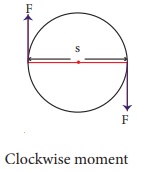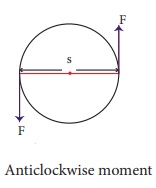
PUMPA - SMART LEARNING
எங்கள் ஆசிரியர்களுடன் 1-ஆன்-1 ஆலோசனை நேரத்தைப் பெறுங்கள். டாப்பர் ஆவதற்கு நாங்கள் பயிற்சி அளிப்போம்
Book Free DemoIn the previous section, we learned rotating effects of force.
In this section, we will discuss about torque and couple.
Moment of the force:
The turning or rotating effect of a force about a fixed axis or fixed point is known as the moment of the force about that point or torque ().
It is measured by the multiplication of the force (\(F\)) and the perpendicular distance (\(d\)) between the fixed axis or the fixed point and the line of action of the force.
Torque is a vector quantity. It acts along the direction, perpendicular to the plane, comprising the line of action of force and the distance.
The SI unit of torque is \(N\ m\).
Couple:
Two equal and unlike parallel forces acting on two different points simultaneously form a couple. The line of action of the two forces does not intersect. It does not create any translatory motion since the resultant is zero. But, a couple results in produces the rotation of the object. The rotating effect of a couple is known as the moment of a couple.Example:
Winding or unwinding a screw, Turning a tap, spinning of a top, etc.,
The moment of a couple (M) is calculated by the product of any one of the forces (F) and the perpendicular distance between the line of action of two forces (S). The turning effect of a couple is determined by the magnitude of its moment.
The SI unit of moment of a couple is a newton metre (\(N\ m\)) and \(dyne\ cm\) in the CGS system.
By convention, the direction of the moment of a force or couple is considered positive if the object is rotated in the anti-clockwise direction and negative if it is rotated in the clockwise direction. They are shown in the below figures.
 |
 |